|
|
|
|
Western Atlantic Coryphopterus
gobies
|
|
|
This large
genus of gobies accounts for the vast majority
of gobies one sees on and around Caribbean
coral reefs. These fishes can be found perching
on the bottom along the sandy edges of reefs,
seemingly everywhere except in the most
turbid or muddy environments. The genus
contains numerous very similar-appearing
species that can be a challenge to distinguish
in the field. Those species that share meristics
can be difficult, even when in hand or preserved
in collections. The advent of DNA barcoding
(identification with a standardized sequence
of the COI gene of mtDNA) allows one to
be certain of identifications and finally
permits accurate diagnosis of indeterminate
individuals. I have sequenced most of the
species in the group as part of my larval
identification studies with the Fish-Bol
team at the Barcode
of Life Project, with some surprising
results (special thanks to Director Bob
Hanner at the University of Guelph). On
this webpage, I discuss the features useful
for species IDs of adults, especially since
most literature sources, including the keys
of Bohlke and Chaplin and derivatives (and,
especially, the line illustrations), depend
on the wrong characters and are confusing
or often plain incorrect.
|
|
|
Coryphopterus
bol from Bonaire; pallid form, courtesy
Brian Mayes
|
|
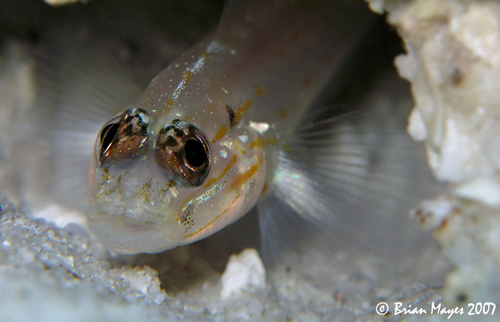 |
|
|
|
|
|
|
|
|
| The
gobies of Coryphopterus are particularly
difficult to identify down to species. The sand-perching
group, in particular, has been taxonomically troublesome
as well, with some species boundaries still unclear.
Using the characters I describe below, it is feasible
(although not always simple) to identify preserved
Coryphopterus specimens in collections where
one can examine melanophore patterns closely. Live
fishes, however, and especially photographs
taken in the field, can sometimes be impossible
to identify to species. It difficult to get pictures
showing all of the diagnostic features for the species
of fish, but the next generation of
CCTV cameras working underwater should provide
better resolution- especially continuous video monitoring
with high quality closed circuit
CCTV cameras.
Most of the sand gobies are distinguished only
by combinations of characters, each of which by
themselves is not sufficient and can occur in
several of the species. As a result, any simple
dichotomous key will be misleading, and would
likely apply only to light or dark individuals,
specific locations, and/or specific size classes.
The results of my barcode mtDNA sequencing for
this group show that the range of variation in
morphology and markings within species is much
greater than is described in the literature. In
addition, a number of newly-recognized cryptic
species are present within the region.
|
|
| Cryptic
species: A difficult problem when using the
literature and field-guides for identifications
is the presence of cryptic species (distinct genetic
lineages with only subtle morphological differences)
among the common 10/10 sand-perching bridled-goby
group. These cryptic species appear very similar
but can have remarkably divergent mtDNA sequences:
I have found about 10% sequence divergence between
some species (with little variation within species).
My sequences are available on the public
database of the Barcode of Life Project.
|
|
| The
traditional "bridled goby", C.
glaucofraenum, splits up into a clade of
five different species. Three of these species are
abundant and widespread in the region and segregate
by habitat, while two others, C.
punctipectophorus and C.
venezuelae, are more localized species at
the temperate edges of the region. C.
punctipectophorus is found in Florida and
the Gulf of Mexico and C.
venezuelae is restricted to NE Venezuela,
an unusual region with many endemic goby and blennioid
species.
|
|
| The
three widespread cryptic species of bridled goby
comprise the originally described C.
glaucofraenum, the "pallid" bridled goby
C.
tortugae, and the new species C.
bol (Victor
2008). C.
tortugae were originally described in 1902
and, as more data became available, recently twice
redescribed more precisely (by Acero in 1990 and
Victor
2008). C.
bol is the more-offshore sibling species
of C.
tortugae and both have been lumped by most
observers as variants of the bridled goby C.
glaucofraenum. To avoid confusion, I propose
that C.
glaucofraenum retain the "inshore bridled
goby" common name ("colon-tail goby"
would be much more apt), while C.
tortugae should be called the "patch-reef
bridled goby" and C.
bol should be called the "canyon bridled
goby" after their distinctive habitats.
|
|
| Markings:
One of the primary causes of the difficulty
in identifying Coryphopterus species in the
western Atlantic is the extreme variability in the
degree of their dark markings with habitat. All
of the sand gobies have lightly marked forms on
white sand in clear water and heavily marked forms
on darker sediments in more turbid waters, particularly
along continental coastlines. This variation can
become extreme in several of the species, particularly
C.
tortugae, C.
bol, C.
eidolon, and C.
thrix, with some individuals showing almost
no markings at all. These occasional very pallid
individuals can be impossible to identify to species
without DNA sequencing. On the other hand, heavily
marked populations of some typically pallid species,
especially the "pallid goby" C.
eidolon and C.
tortugae, have not been recognized and are
assigned to other species in museum collections. |
|
| The
sand-goby clade share their basic marking patterns
and differ mostly in the extent and orientation
of the markings. Most marking differences are quite
subtle and, unfortunately, overlap to some degree.
Several sets of body markings diverge as juveniles
develop and become diagnostic characters. The marking
patterns of most utility are the spots, stripes,
and bars on the top and sides of the head, around
the eye, at the pectoral-fin base, and at the base
of the caudal fin. |
|
| Live
sand gobies have somewhat different markings from
preserved fishes. The primary colors on living sand
gobies are orange and iridescent blue/white. Black
markings made up of melanophores are scattered over
the body and typically outline and underlie the
orange markings. The blue and white markings are
rarely outlined or underlain by melanophores, with
the notable exception of the white bridle stripe
across the cheek which can have an underlying stripe
of melanophores (probably accenting the reflectivity
in live fishes). Upon preservation, the orange disappears
rapidly. The blue and white markings fade to some
degree, but can often be discerned in preserved
fishes. Indeed, the white markings are still visible
on the hundred-year-old holotype of C.
tortugae. The dark markings, i.e. the melanophore
patterns, are best preserved and most useful in
the detailed descriptions discussed below.
|
|
|
Coryphopterus
bol from Exuma, Bahamas; pallid form,
courtesy Steve Roos
|
|
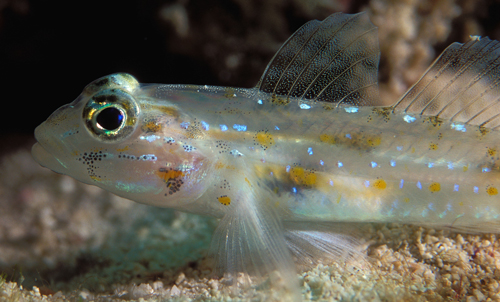 |
|
|
| The
process of identification is further complicated
by a great deal of intraspecific variation in some
markings, often in the very patterns that are typically
used to identify species; for example, the characteristic
round colon-like pectoral-fin base spots of the
colon goby, C.
dicrus, are often not round and often do
not form the distinctive colon mark. Most markings
and morphological characters that have been considered
diagnostic for species in the literature are variably
present, and can often be found on other species
as well. |
|
| The
sand gobies also show marked individual variation
in morphology, with some specimens wider-bodied
or with larger heads (note the paratypes of C.
bol below). This variation interacts with
marking variations; the diagnostic spots and stripes
are variously moved and stretched with the shape
changes, sometimes making a character no longer
useful for distinguishing two species. |
|
| Fortunately,
a few markings develop at transition and are, to
coin a word, "taxognomonic", i.e. uniquely
diagnostic- such as the mid-body bar and dorsal-fin
base spot in C.
alloides. Some are taxognomonic and appear
early, for example the speckled upper eyeball in
C. thrix.
Nevertheless, most sand gobies are distinguished
only by combinations of characters, each of which
by themselves is not sufficient and can occur in
a subset of species. This problem becomes acute
for the bridled goby clade and several characters
need to be examined closely to be certain of the
species. Note, however, that this applies mostly
to intermediate individuals- many specimens have
unambiguous combinations of markings that can make
identification straightforward. Unfortunately, some
juveniles, most very pallid individuals, and some
breeding males (often uniformly dusky), can be missing
the diagnostic markings. |
|
|
| Fin-ray
counts can be very useful in separating species
of sand gobies and are much less variable than morphology
or markings. However, many of the more difficult
species share the 10/10 fin ray formula. |
| |
|
The reported fin-ray counts
for the genus Coryphopterus in the literature:
|
|
|
format= Species: #dorsal/#anal-fin
elements #pectoral rays (pelvic-fin state)
|
|
|
The Sand Gobies
|
|
10/10 group
(widespread and abundant species)
C.
glaucofraenum: Randall: 10/10 pect 17-20
Bohlke: 10/10, rare 9 pect 17-20 usu 19
C.
tortugae: Acero: 10/10 pect 18-20
C. bol:
Victor
2008: 10/10 pect 18-20
C.
eidolon: Randall: 10 (11 was a typo)/9-10,
mode 10 pect 19-20, rare 18 Bohlke: 10/10,
rare 9 pect 19-20
C.
thrix: Bohlke: 9-10/10 pect 17-19
C.
dicrus: Randall: 10/10 pect 18-20 Bohlke:
10/10 pect 18-20
11 group
(localized endemics)
C.
punctipectophorus: Bohlke: 11/10 pect
18-20 (South Carolina to the Gulf of Mexico)
C.
venezuelae: Cervigon: 11/11 pect 18-20
(NE Venezuela: limted to the Gulf of Cariaco (Cumana),
Isla Cubagua, Isla Margarita, & the Mochima
region)
fewer than 10
C.
kuna: 9/9 pect 14-15 (widespread
Caribbean and Florida)
C.
alloides: 10/9 Bohlke: 10, rare
9/9 pect 16-17 (divided pelvic fins) widespread
|
|
|
The Reef Gobies
|
|
C.
lipernes: 10/10 pect 16-18 (divided pelvic
fins)
C.
hyalinus: 10/10 pect 14-16 (divided pelvic
fins)
C.
personatus: Randall: 11/11 pect 14-16
(occ. 10/10) Bohlke: 10-11, mode 11/10-11,
mode 11 pect 14-16 (divided pelvic fins)
|
|
|
Note: fin-ray counts for the second dorsal fin and
the anal fin are total elements (spines plus rays) |
|
|
|
|
|
| Coryphopterus glaucofraenum |
|
|
|
|
|
|
| |
|
|
|
Diagnosis: Coryphopterus
glaucofraenum, or the bridled goby, is one
of several 10/10 sand gobies. Several other sand
gobies have the same white under-eye bridle stripe,
thus a more apt common name would be the colon-tail
goby, the most obvious character of C. glaucofraenum
(or perhaps the "inshore bridled goby").
This species is typically found in inshore habitats:
it accounts for virtually all the sand gobies
in silty mangrove or turbid-water shallows, many
of the sand gobies in shallow bays with mixed
reef/sand habitat, and only occasionally on offshore
patch reefs or deeper habitats. Populations in
mangrove areas and silty shallows are heavily-marked
and relatively simple to identify, while those
living in clear-water sandy bays and shallow patch
reefs are lightly-marked and can be difficult
to separate from other sand gobies.
The suite of characters that distinguish adult
C. glaucofraenum comprise (in order of
usefulness):
|
|
|
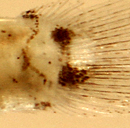
|
two
colon-like spots at the caudal-fin base, distinctly-rounded
and mostly separate on lightly-marked fish, joined
by a constricted bridge on darker fish, but with
distinctly rounded end-spots
-present at all sizes, darker fish can have extensive
bridging |
vs.
most other sand gobies, which have a bar
-except C.
venezuelae which shares the colon-like spots
and some light C.
tortugae in which the bar breaks into two
segments
- some dark C.
bol can have a thick dumbell bar
-C.
punctipectophorus have colon spots, but
not conspicuous, same intensity as body spots |
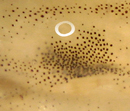 |
two-pronged
wide dark dorsal projection on the mid eye-stripe
over the mid-opercle, prongs split around a white
spot elevated above its row (bridging black is raised
over stripe level), anterior prong lower than posterior
-develops on mature adults; useful when present,
smaller adults can have no projections |
vs.
C.
tortugae, C.
bol, and C.
venezuelae, which have a simple triangle
(they can have a very small anterior spike); white
spot behind the triangle usually not much elevated-
if the spot is bracketed by black, then anterior
triangle larger than posterior
-other sand gobies have no dark projections in that
location |
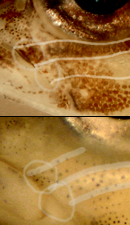
|
the
melanophore component of the orange lower eye-stripe
continues as a straight dark stripe forward across
the suborbital to the tip of the jaw; even light
fish have a dark edge at the crossing of the suborbital
at mid-maxilla- i.e. above the fleshy lip (premaxilla)
and just above the white bridle and its melanophore
stripe
-on juveniles the stripe can be interrupted by the
eyeball, on larger and lighter adults the dark-on-orange
stripe curves down, but still above the white bridle |
vs.
C.
tortugae and C.
bol, with no dark stripe on the anterior
orange segment of under-eye stripe: instead the
dark stripe merges down to the white bridle and
its melanophore stripe, leaving the 8 o'clock suborbital
region unmarked; no dark edge at the crossing of
the suborbital at mid-maxilla (behind the lip, at
the end of the orange stripe); on light fish a simple
patch or bar of melanophores under the eye at 6-7
o'clock
-C.
venezuelae shares the straight-line stripe |
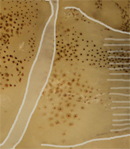 |
no discrete
outlined dark spot on the lower pectoral-fin base
on pale fish (can be sparsely speckled); some dark
fish can have a diffuse patch of melanophores (not
sharply-outlined), sometimes trailing up to meet
the upper fin base markings
-small juveniles can have no marks or a cluster
of 3-4 solitary central melanophores |
vs.
C. bol,
C. dicrus,
and C.
venezuelae, which have a sharply-outlined
dark spot, usually round or a long oval or an upward-facing
crescent (however, small juveniles and pallid fish
can have no marks or just a few central melanophores)
-C.
eidolon and C.
thrix also have variable shading, speckling,
and spots. |
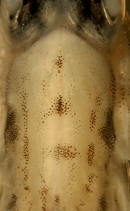 |
upper
eye-stripe complete or broken into segments, not
round spots |
vs.
C. dicrus
(and sometimes C.
eidolon and C.
thrix), which have rounded spots instead
of an upper eye-stripe |
| dorsal
midline head spots with chain link loops |
vs.
C.
tortugae and C.
dicrus, which have no complete loops or
rounded spots (respectively) |
| pelvic
fin fused, frenum well-developed |
vs.
C.
alloides with divided pelvic fins and C.
dicrus with no frenum |
| innermost
pelvic-fin rays usually about equal to next (many
exceptions) |
vs.
C. dicrus,
C.
eidolon, C.
alloides, many C.
thrix, and occasional individuals of other
sand gobies, which have shorter innermost rays |
| Coryphopterus
glaucofraenum |
| colon spot tail, dark
on orange anterior under-eye stripe (curves
down on large fish), elevated second white
spot on mid-eye stripe, no lower pectoral
base spot |
| Florida,courtesy Paul
Osmond |
|
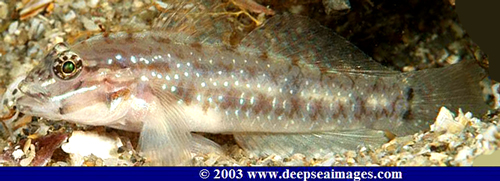 |
| Coryphopterus
glaucofraenum light |
| colon spot tail, dark
on orange anterior under-eye stripe (curves
down on large fish), no lower pectoral spot |
| Bermuda, courtesy George
Lin |
|
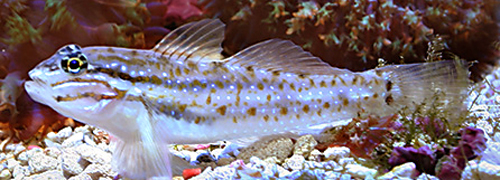 |
| Dark
form, inshore silty and mangrove habitat: |
| Coryphopterus
glaucofraenum dark |
| 11.5 mm SL, juvenile,
10/10 |
| Mochima, Venezuela,
GCRL 15947 |
|
 |
 |
|
| Coryphopterus
glaucofraenum dark |
| 21.3 mm SL, 10/10 |
| note under-eye stripe
straight to tip |
| lower pectoral patch
without sharp edges |
| Mochima, Venezuela,
GCRL 15947 |
|
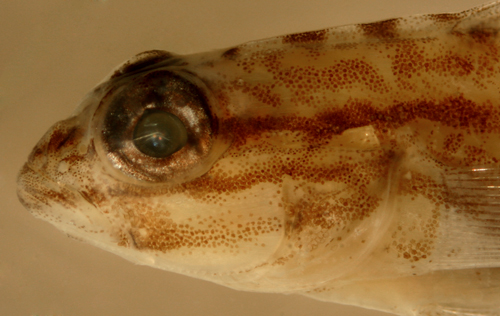 |
 |
|
| Coryphopterus
glaucofraenum dark |
| 24.5 mm SL, DNA confirmed
ID |
| note under-eye dark
stripe across to tip |
| lower pectoral patch
without sharp edges |
| Colon, Panama N7531a |
|
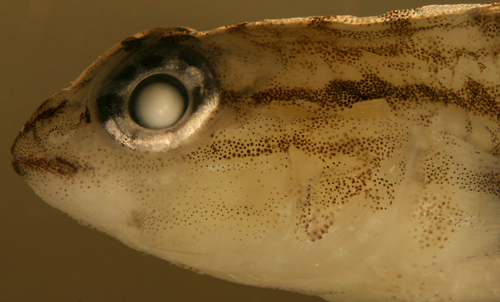 |
 |
|
| Coryphopterus
glaucofraenum dark |
| 30.1 mm SL, female,
DNA confirmed ID |
| note under-eye stripe
curves down |
| no pectoral spot, two
prong projection |
| Colon, Panama N7527b |
|
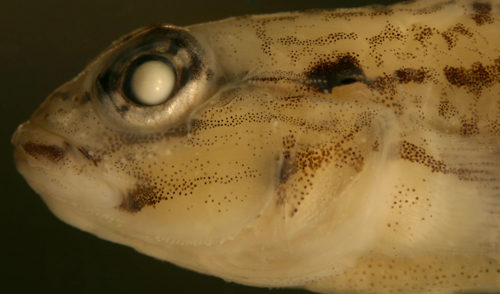 |
| Light
form, shallow sandy bays and patch reefs: |
 |
|
| Coryphopterus
glaucofraenum light |
| 13.1 mm SL, juvenile,
DNA confirmed ID |
| lower eye-stripe and
8 o'clock spots |
| St. Thomas, USVI, ST307a |
|
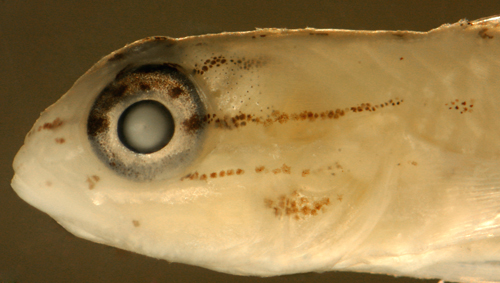 |
 |
|
| Coryphopterus
glaucofraenum light |
| 28.8 mm SL, DNA confirmed
ID |
| note dark edge at crossing
mid-maxilla |
| two pronged projection,
no pectoral spot |
| upper eye-stripe variable,
chain-link loops |
| St. Thomas, ST307 |
|
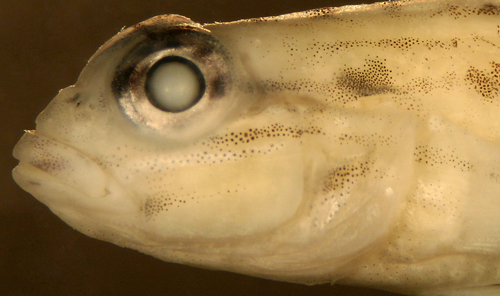 |
|
|
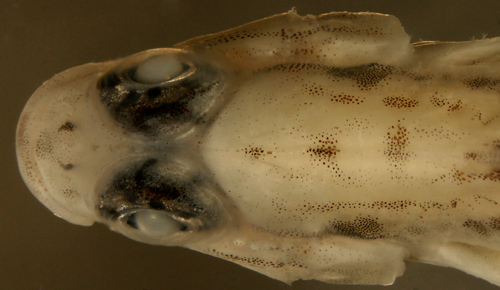 |
 |
|
| Coryphopterus
glaucofraenum light |
| 32.3 mm SL male, DNA
confirmed ID |
| note dark edge at crossing
mid-maxilla |
| two pronged projection,
no pectoral spot |
| colon tail spots, notched
pelvic fin |
| St. Thomas, ST307 |
|
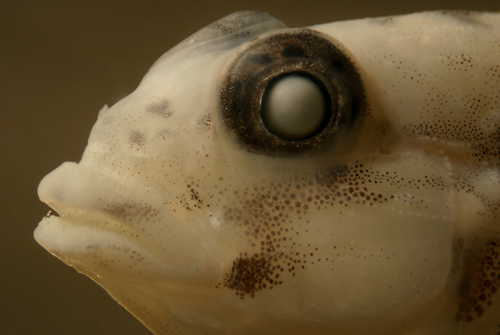 |
|
|
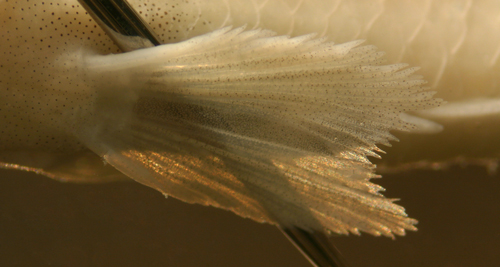 |
|
|
|
|
|
|
|
|
|
Diagnosis: Coryphopterus
tortugae, or the patch-reef goby, is one of
several 10/10 sand gobies. This species is typically
found in shallow patch reef environments: it accounts
for most of the sand gobies on mid-shelf reefs
and around patch reefs in clear water (less than
30 feet deep) and many of the sand gobies in shallow
bays with mixed reef/sand habitat. Many populations
are pallid, some with very few markings (these
cannot always be easily separated from very pallid
individuals of similar species, especially C.
bol, C.
thrix, and C.
eidolon). There is no single diagnostic
feature of C. tortugae: a combination of
characters, and, in particular, the absence of
diagnostic features of other species, is critical.
The suite of characters that distinguish adult
C. tortugae comprise (in order of usefulness):
|
|
|
|
|
simple
triangular dark dorsal projection (point-up)
on the mid eye-stripe over the mid-opercle
(sometimes with a very small anterior spike);
white spot behind the triangle usually not
elevated; if the spot is followed by another
dark triangle, anterior triangle larger than
posterior
-develops on large juveniles and adults |
vs. C.
glaucofraenum, which have a wide
two-pronged dorsal projection split around
a white spot elevated above its row (bridging
black is raised over stripe level), anterior
prong lower than posterior
-other sand gobies have no such dark marks
-C.
bol and C.
venezuelae share the triangles
|
| |
no
dark lower pectoral-fin base markings; on
some breeding adults there can be fine speckling
continuous with thoracic speckling |
vs.
C.
bol, C.
dicrus, and C.
venezuelae, which have a sharply-outlined
dark spot; dark C.
eidolon and
C. alloides, which have a variable
spot or stripe; and
C.
glaucofraenum, which have speckling
or shading (note that pallid individuals of
all species can have no markings) |
| |
on lighter fish a simple patch or bar of
melanophores under the eye at 6-7 o'clock;
no dark stripe at the anterior orange segment
of the under-eye stripe: instead the dark
lower-eye stripe merges with the white bridle
and its melanophore stripe, leaving the
8 o'clock suborbital region unmarked (dark
fish can have a speckling in that region);
no dark edge of the suborbital at mid-maxilla
(behind the lip, at the end of the orange
stripe, above the white bridle)
-present at all sizes
|
vs. C.
glaucofraenum and C.
venezuelae, on which the melanophore
component of the orange lower eye-stripe continues
as a straight dark stripe forward across the
suborbital to the tip of the jaw (even light
fish have a dark edge of the suborbital at
mid-maxilla, behind the lip, just above the
white bridle and its melanophore stripe)
-C.
bol share the pattern; C.
dicrus variable; C.
eidolon and C.
thrix have no under-eye stripe |
| |
upper
eye-stripe broken into linear segments, midline
head spots discrete with no connecting chain-link
loops
-rare dark fish with complete upper eye-stripe,
and incomplete chain links |
vs.
C.
glaucofraenum and C.
venezuelae, which have chain-link
loops; C.
bol, which have a both a complete
upper eye-stripe and chain link loops; and
C.
dicrus (and sometimes C.
eidolon and C.
thrix) which have rows of rounded
spots on top of the head |
| |
basicaudal
bar usually a simple bar, some light fish
have the bar broken into two segments, often
with bridging melanophores, not usually obviously
rounded |
vs.
C.
glaucofraenum and C.
venezuelae, which have two rounded
colon-like spots at the caudal-fin base, separate
on light fish, joined by a constricted bridge
on darker fish, but with distinctly rounded
end-spots
-other species share a variable bar |
| |
innermost
pelvic-fin rays usually about equal to next |
vs.
C.
dicrus , C.
alloides, and many C.
thrix, as well as occasional individuals
of other sand gobies, which have shorter innermost
rays |
| |
innermost
pelvic-fin rays usually about equal to next |
vs.
C.
dicrus, C.
eidolon, C.
alloides, many C.
thrix, and occasional individuals
of other sand gobies, which have shorter innermost
rays |
|
| Coryphopterus
tortugae |
| mid-eye stripe with
dark triangle; no black on anterior orange
segment of under-eye stripe; no lower pectoral-fin
base spot; broken upper-eye stripe, no loops
|
| belize, courtesy Paddy
Ryan |
|
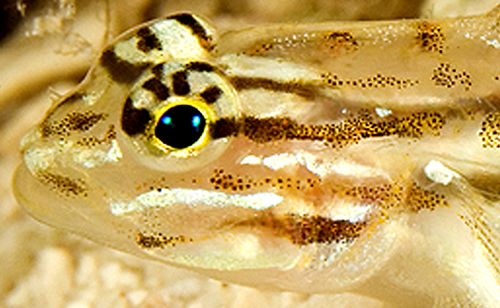 |
| Coryphopterus
tortugae |
| basicaudal bar broken
into two, but not rounded spots |
| Belize, courtesy Paddy
Ryan |
|
 |
| Coryphopterus
tortugae |
| 36.8 mm SL, DNA confirmed
ID |
| La Parguera, Puerto
Rico pr789 |
|
 |
| Coryphopterus
tortugae |
| 36.8 mm SL, DNA confirmed
ID |
no lower pectoral-fin
base spot,
broken upper eye-stripe
no stripe to tip of jaw or 8 o'clock bar |
| La Parguera, Puerto
Rico pr789 |
|
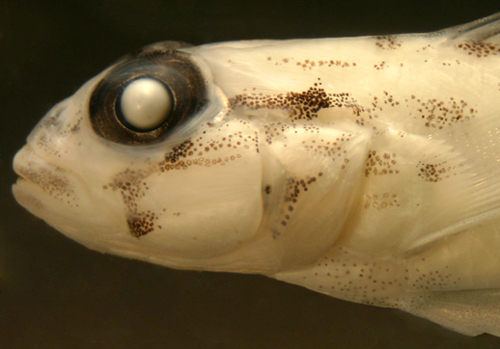 |
| Coryphopterus
tortugae |
| 32.0 mm SL, DNA confirmed
ID |
most heavily-marked
form, with:
no lower pectoral-fin base spot,
complete upper eye-stripe but no links,
no stripe to tip of jaw or 8 o'clock bar |
| La Parguera, Puerto
Rico pr7811 |
|
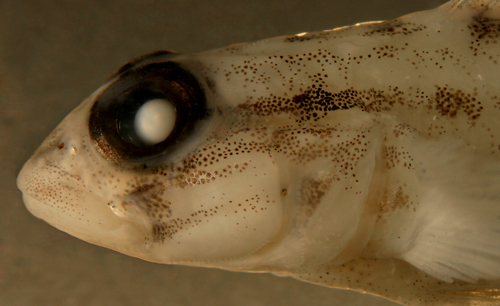 |
| Coryphopterus
tortugae |
| 27.0 mm SL, DNA confirmed
ID |
| midline spots, no upper
eye-stripe |
| La Parguera, Puerto
Rico pr784b |
|
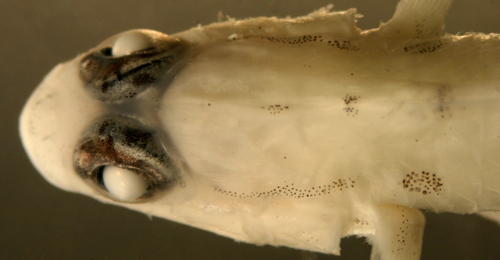 |
| Coryphopterus
tortugae |
| 28.5 mm SL, DNA confirmed
ID |
| midline spots, broken
upper eye-stripe |
| La Parguera, Puerto
Rico pr784b |
|
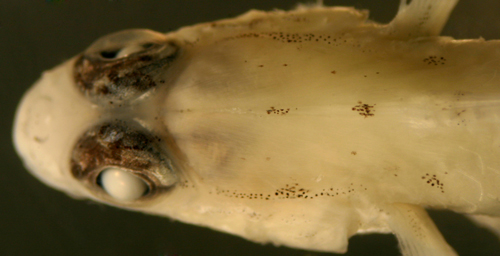 |
| Coryphopterus
tortugae |
| 23.8 mm SL, DNA confirmed
ID |
| midline spots, broken
upper eye-stripe |
| La Parguera, Puerto
Rico pr7811 |
|
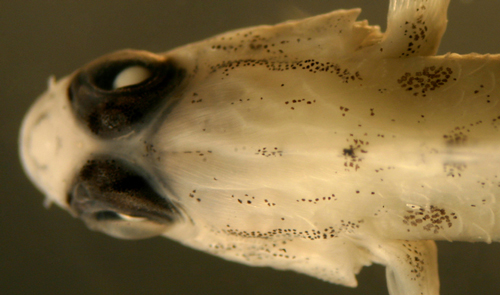 |
| Coryphopterus
tortugae |
| 25.1 mm SL, DNA confirmed
ID |
| midline spots, broken
upper eye-stripe |
| La Parguera, Puerto
Rico pr7811 |
|
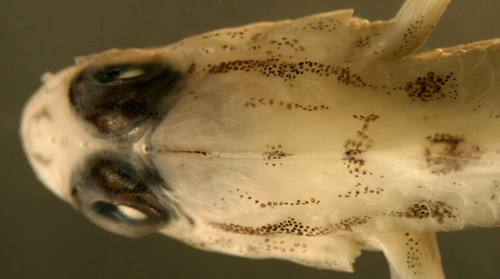 |
| Coryphopterus
tortugae dark |
| 32.0 mm SL, DNA confirmed
ID |
midline spots, not
clearly linked to
mostly complete upper eye-stripe |
| La Parguera, Puerto
Rico pr7811 |
|
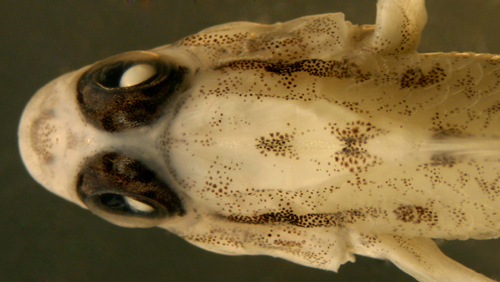 |
| Ctenogobius
transparentus holotype, 1958 |
| synonym of Coryphopterus
tortugae |
| triangle mark, no discrete
pectoral spot |
| courtesy H. Zetzsche,
Sencken. Museum |
|
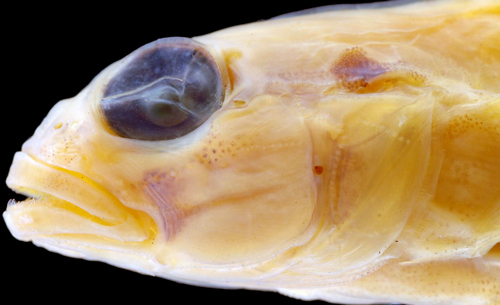 |
| Coryphopterus
tortugae holotype (1902) |
| triangle projection,
broken upper eye-stripe |
| courtesy D. Catania
and J. Fong, CAS |
|
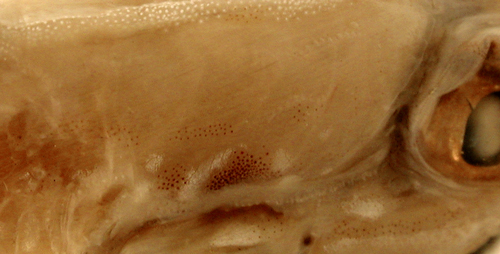 |
|
|
|
|
|
|
|
|
|
|
|
|
Diagnosis: Coryphopterus
bol, or the sand-canyon goby, is one of several
10/10 sand gobies. This recently-described
species is typically found on deeper offshore
reefs: it accounts for most of the sand gobies
in offshore buttress-canyon habitats and around
rocky points with strong currents. It is the abundant
sand goby found in sand channels around dropoffs
on continental coastlines with strong currents.
Many populations are pallid, some with very few
markings (these cannot always be easily separated
from very pallid individuals of similar species,
especially C.
tortugae, C.
thrix, and C.
eidolon).
The suite of characters that distinguish adult
C. bol comprise (in order of usefulness):
|
|
|
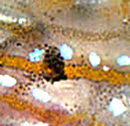
|
simple
triangular dark dorsal projection (point-up) on
the mid eye-stripe over the mid-opercle (sometimes
with a very small anterior spike); white spot behind
the triangle usually not elevated; if the spot is
followed by another dark triangle, anterior triangle
larger than posterior
-develops on large juveniles and adults |
vs. C.
glaucofraenum, which have a wide two-pronged
dorsal projection split around a white spot elevated
above its row (bridging black is raised over stripe
level), anterior prong lower than posterior
-other sand gobies have no such dark marks
-C.
tortugae and C.
venezuelae share the triangles
|
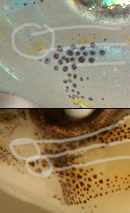 |
on lighter fish a simple patch or bar of melanophores
under the eye at 6-7 o'clock;
no dark stripe at the anterior orange segment
of the under-eye stripe: instead the dark lower-eye
stripe merges with the white bridle and its melanophore
stripe, leaving the 8 o'clock suborbital region
unmarked (dark fish can have a speckling in that
region); no dark edge of the suborbital at mid-maxilla
(behind the lip, at the end of the orange stripe,
above the white bridle)
-present at all sizes
|
vs.
C.
glaucofraenum and C.
venezuelae, on which the melanophore component
of the orange lower eye-stripe continues as a straight
dark stripe forward across the suborbital to the
tip of the jaw (even light fish have a dark edge
of the suborbital at mid-maxilla, behind the lip,
just above the white bridle and its melanophore
stripe)
-C.
tortugae share the pattern; C.
dicrus variable
-C.
eidolon and C.
thrix have no under-eye stripe |
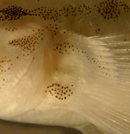 |
sharply-outlined
dark spot at the lower pectoral-fin base, usually
a long upward-facing crescent or oval
-can be absent on new recruits and very pallid individuals |
vs.
C.
glaucofraenum, C.
tortugae, and
C. thrix,
which are variously unmarked, have a broad stripe
or unshaped speckling on the lower pectoral-fin
base
-C.
venezuelae share the same-shaped spot,
C. dicrus have a round or oval spot, dark
C.
eidolon have a variable spot, and C.
alloides have a stripe |
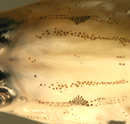 |
complete
upper eye-stripe with short and linear midline head
spots (often bracketing the exact midline), some
fish develop adjacent lyre-like curves, on dark
fish they form loops of melanophores in a chain-link
pattern
-can be absent on light fish or broken on small
juveniles |
vs.
C. tortugae, which have a broken upper eye-stripe
with round midline head spots and no chain-link
loops (partial on the darkest fish); and C.
dicrus, which have rounded spots instead
of an upper eye-stripe
-C.
glaucofraenum and C.
venezuelae can share the pattern, C.
eidolon and C.
thrix are variable |
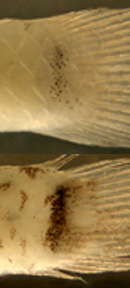 |
basicaudal
bar usually a simple bar on lighter fish, some light
fish have two segments with some bridging melanophores
(not distinctly rounded); darker fish have a thick
C-shape or a thick dumbell shape. |
vs.
C.
glaucofraenum and C.
venezuelae, which have two rounded colon-like
spots at the caudal-fin base, separate on light
fish, joined by a constricted bridge on darker fish,
but with distinctly rounded end-spots
-other species share a variable bar |
| pelvic
fin fused, frenum well-developed |
vs.
C.
alloides with divided pelvic fins and C.
dicrus with no frenum |
| innermost
pelvic-fin rays usually about equal to next |
vs.
C. dicrus,
C.
eidolon, C.
alloides, many C.
thrix, and occasional individuals of other
sand gobies, which have shorter innermost rays |
| Coryphopterus
bol |
| mid-eye stripe with
dark triangle; no black on anterior orange
segment of under-eye stripe; lower pectoral
base spot sharply-outlined; complete upper-eye
stripe |
| Bonaire, courtesy Les
Wilk |
|
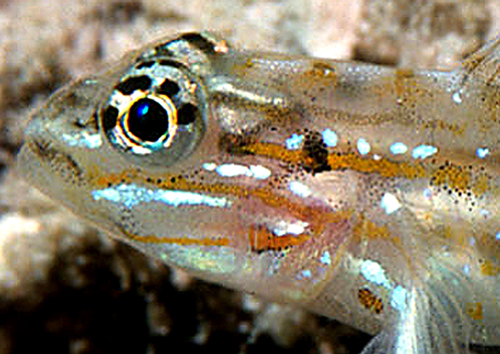 |
| Coryphopterus
bol juvenile |
| 22.5 mm SL, DNA confirmed
ID |
| lower pectoral base
spot, no 8 o'clock bar |
| or stripe, complete
upper eye-stripe |
| Colon, Panama n7530a |
Coryphopterus
bol
holotype (top)
paratypes(three below) |
|
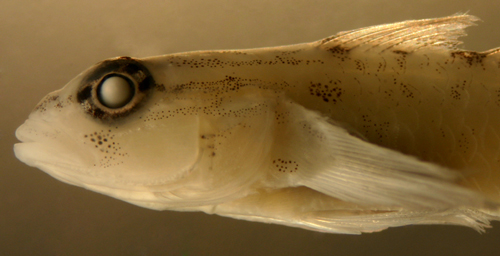 |
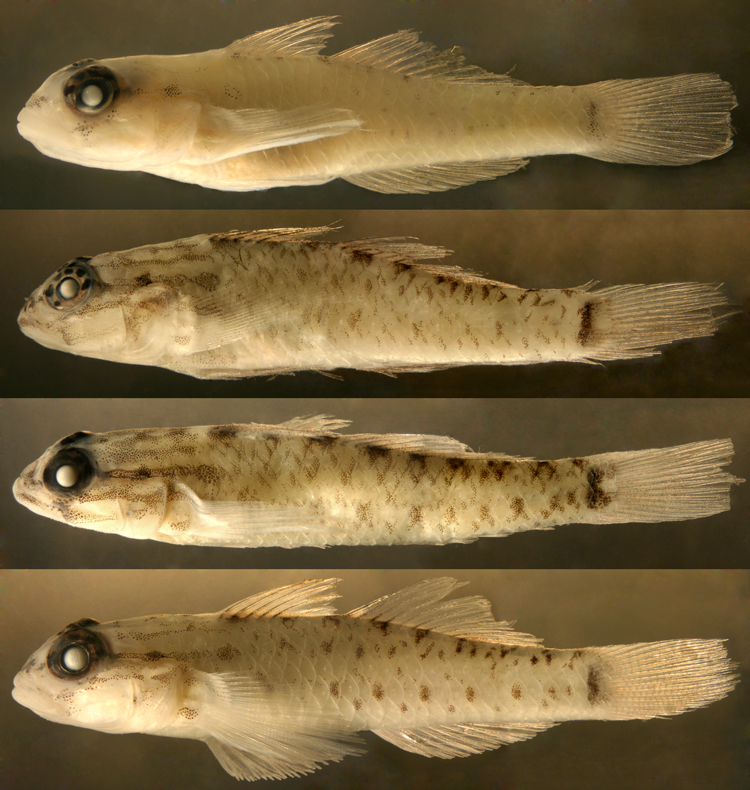 |
| Coryphopterus
bol holotype |
| 26.8 mm SL, DNA confirmed
ID |
pallid type: few head
melanophores, but
spot developing at lower pectoral-fin base |
| La Parguera, Puerto
Rico, pr785a |
|
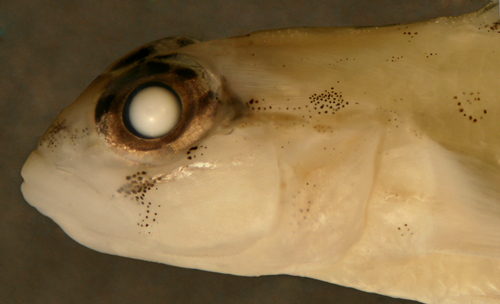 |
| Coryphopterus
bol |
| Exuma, Bahamas |
| courtesy Steve Roos |
|
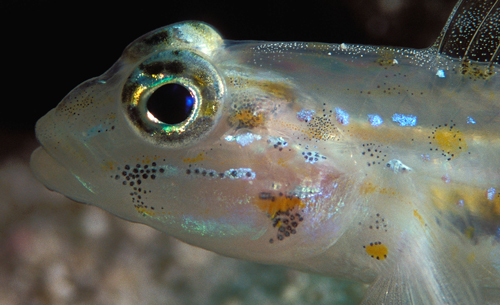 |
| Coryphopterus
bol paratype |
| 32.1 mm SL, DNA confirmed
ID |
long-oval lower pectoral-fin
base spot,
complete upper eye-stripe
no stripe to tip of jaw or 8 o'clock bar |
| La Parguera, Puerto
Rico, pr7811 |
|
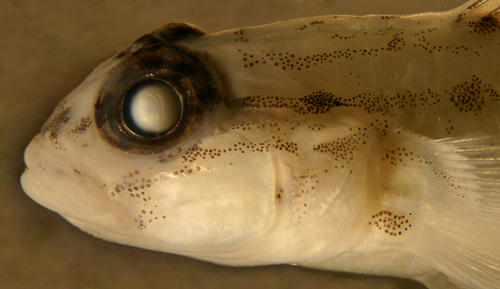 |
| Coryphopterus
bol paratype |
| 28.0 mm SL, DNA confirmed
ID |
long oval pectoral
base spot, triangle projection, complete upper
eye-stripe
but under-eye stripe indeterminate |
| Colon, Panama N7530a |
|
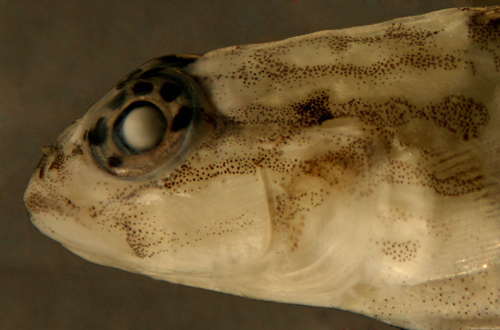 |
| Coryphopterus
bol paratype |
| 24.5 mm SL, DNA confirmed
ID |
long oval pectoral
base spot, triangle projection, complete upper
eye-stripe,
under-eye stripe not straight to tip |
| St. Thomas, USVI ST80629 |
|
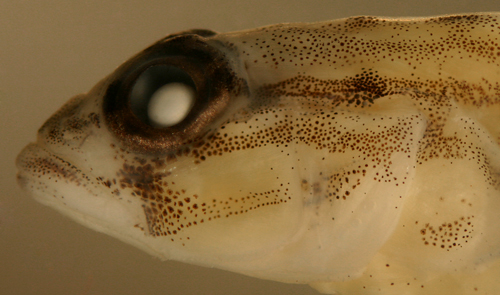 |
| Coryphopterus
bol? |
| definite bar at tail,
not colon spots |
| Florida, photo by P.
Leahy |
|
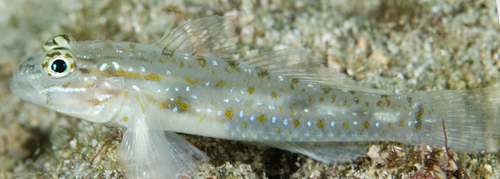 |
| Coryphopterus
bol |
| with variant markings? |
i.e. upper eye-stripe
broken, under-eye stripe indeterminate, lower
pectoral base dark spot not sharply outlined
but good triangle projection and tail bar,
rules out C. glaucofraenum |
| Florida, photo by P.
Leahy |
|
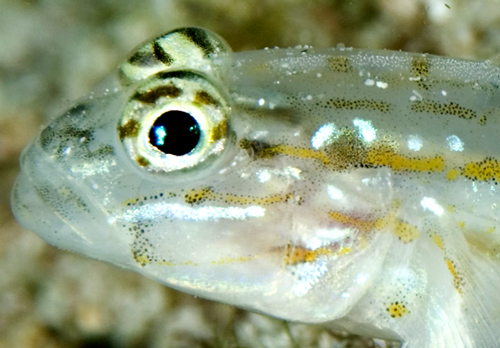 |
| Coryphopterus
bol holotype |
| 26.8 mm SL, DNA confirmed
ID |
upper eye-stripe developing,
while midline bare |
| La Parguera, Puerto
Rico, pr785a |
|
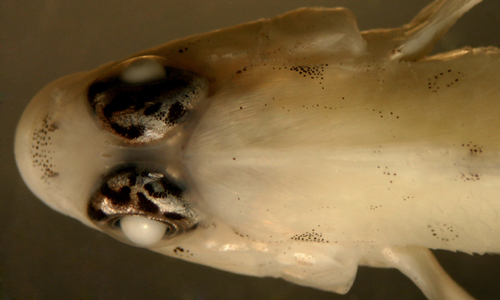 |
| Coryphopterus
bol paratype |
| 24.5 mm SL, DNA confirmed
ID |
upper eye-stripe complete
midline with only short lines off-center |
| La Parguera, Puerto
Rico, pr785 |
|
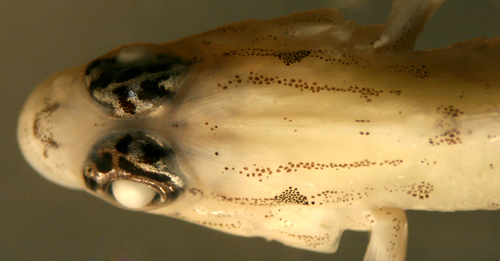 |
| Coryphopterus
bol paratype |
| 23.7 mm SL, DNA confirmed
ID |
upper eye-stripe complete,
fine
loops connecting midline off-center lines |
| La Parguera, Puerto
Rico, pr785 |
|
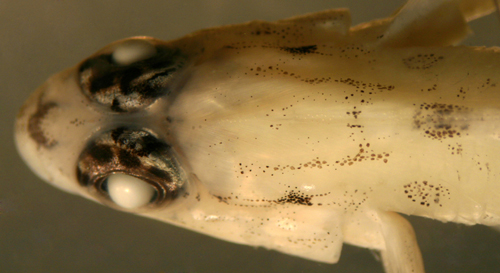 |
| Coryphopterus
bol paratype |
| 32.1 mm SL, DNA confirmed
ID |
upper eye-stripe mostly
complete
loops forming chain links |
| La Parguera, Puerto
Rico, pr789 |
|
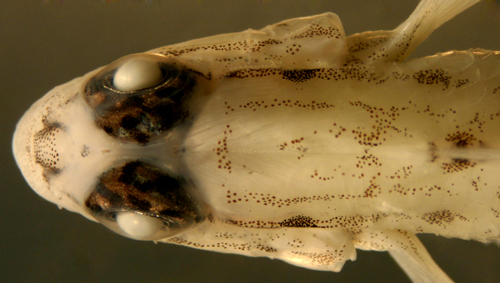 |
| Coryphopterus
bol paratype |
| 22.5 mm SL, DNA confirmed
ID |
upper eye-stripe complete
off-center lyre-like lines starting loops |
| Colon, Panama N7530a |
|
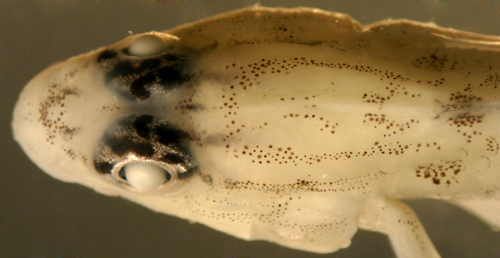 |
| Coryphopterus
bol paratype |
| 28.0 mm SL, DNA confirmed
ID |
upper eye-stripe complete,
connecting
at ends with chain link pattern |
| Colon, Panama N7530a |
|
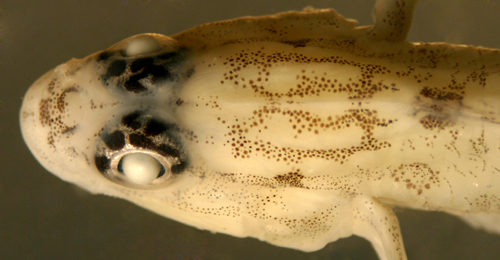 |
| Coryphopterus
bol paratype |
| 24.5 mm SL, DNA confirmed
ID |
upper eye-stripe complete
full chain link pattern |
| St. Thomas, USVI, 307
|
|
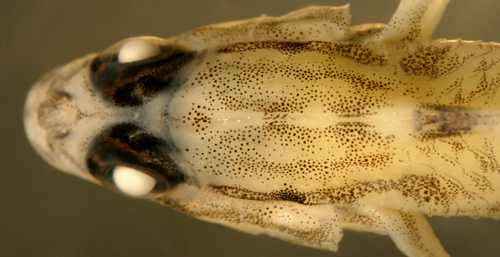 |
| |
|
|
|
|
|
|
|
|
|
|
Diagnosis: Coryphopterus
dicrus, or the colon goby, is one of several
10/10 sand gobies. This species is found in a
variety of habitats, although rarely in inshore
silty or mangrove sites.
Unfortunately, the diagnostic colon-like marks
on the pectoral-fin base are often not present,
and then the identification is based on a combination
of features. The suite of characters that distinguish
adult C. dicrus comprise (in order of usefulness):
|
|
|
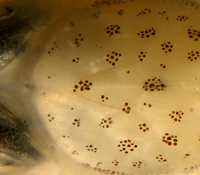 |
irregular rows of rounded spots (at the surface)
instead of an upper eye-stripe, evenly distributed
on the top of the head
-on live fish there is usually a short subsurface
upper eye-stripe (halfway back to the dorsal
fin)
-present on juveniles and adults |
vs.
C.
glaucofraenum, C.
tortugae, C.
bol, and C.
venezuelae, which have an upper eye-stripe
(complete or segments) and chain-link loops
-C.
thrix and C.
eidolon can sometimes also have the
upper eye-stripe broken into rounded spots |
| |
body
freckled with numerous discrete small dark
spots between larger spots and X-marks (sized
from a tenth to a fifth of a pupil diameter)
-present on juveniles and adults |
vs.
other sand gobies, with larger dark spots
and X-marks, few intervening freckles
-C.
thrix and C.
eidolon can have medium dark spots
(from a fifth to a third of pupil diameter) |
| |
sharply-outlined
round or oval dark spot on the upper
pectoral-fin base
-only on some adults (then is diagnostic);
but many have only a broad stripe |
vs.
all other sand gobies, which have a broad
stripe on the upper base; C.
thrix and C.
eidolon often have a large uniform
dark patch covering the upper pectoral-fin
base |
| |
sharply-outlined
round or oval dark spot at the lower pectoral-fin
base
-on most adults |
vs.
most other sand gobies which are variously
unmarked, have a broad stripe or unshaped
speckling on the lower pectoral-fin base
-C.
punctipectophorus, C.
venezuelae and C.
bol also
have an outlined spot, oval or round |
| |
lower
eye-stripe usually continues below the eye |
vs. C.
thrix and C.
eidolon, in which the lower eye-stripe
does not run under the eye |
| |
lower
cheek stripe extends straight across the cheek
to the opercle, pointing towards the pectoral-fin
base |
vs. C.
thrix and C.
eidolon, which often have a short
lower cheek stripe angled sharply-upward,
pointing forward of the dorsal-fin origin |
| |
pelvic
fin fused, but frenum absent in adults |
vs.
all other sand gobies, which have an obvious
frenum
-except C.
alloides with no pelvic frenum |
| |
innermost
pelvic-fin rays shorter than the next ray
-develops after about 20 mm SL |
-C.
eidolon, C.
alloides, many C.
thrix, and occasional individuals
of other sand gobies have shorter innermost
rays |
|
|
no
dark projection on the mid eye-stripe above
the opercle (can have a small triangle just
behind the eye, above the preopercle) |
vs.
C.
glaucofraenum, C.
tortugae, C.
bol, and C.
venezuelae, which have triangular
or oblong dark dorsal projections on the mid
eye-stripe (on larger juveniles and adults) |
|
| Coryphopterus
dicrus |
|
| rounded spots over
the top of the head |
| round spot only on
lower pectoral-fin base |
| US Virgin Islands |
| courtesy Nathan Lovas,
nathanlovas.com |
|
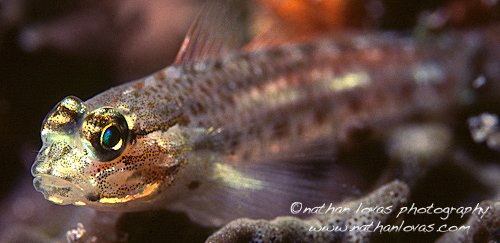 |
| Coryphopterus
dicrus |
| Holbox, Yucatan (edge
of Gulf of Mexico) |
| courtesy Hilario Itriago,
letsseatv.com |
|
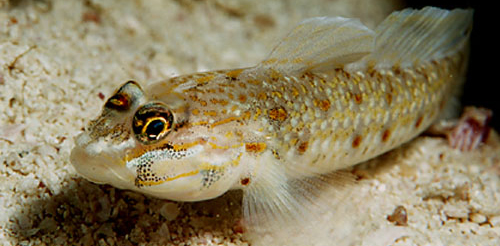 |
| Coryphopterus
dicrus |
| 20.0 mm SL, DNA confirmed
ID |
| round spots on top
and side of head |
| round colon-like spots
on pectoral-fin base |
| St. Thomas, USVI, st307a |
|
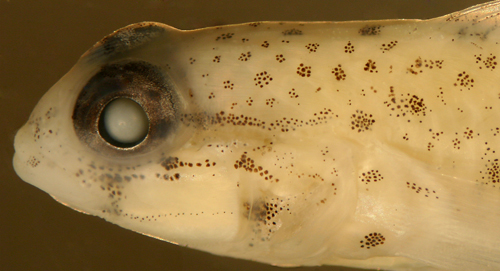 |
|
|
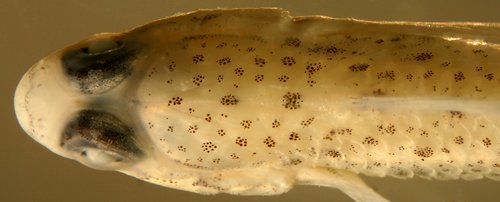 > > |
|
|
|
|
|
|
|
|
|
Diagnosis: Coryphopterus
eidolon, or the pallid goby, is one of several
10/10 sand gobies. Its common name is a misnomer:
there are heavily-marked populations of this species
(usually misidentified in collections) and pallid
versions of some other sand goby species, especially
C.
tortugae, C.
bol, and C.
thrix. A more apt common name would be
the wall sand-goby, since this species has no
unique morphological character, but is found mostly
occupying deeper wall habitats. C. eidolon
is typically found in sand channels draining through
the dropoffs in deep clear water without strong
currents. At most locations, specimens are pallid
and have only orange markings in the place of
dark markings, although often outlined in tiny
melanophores. When preserved, these fishes can
be almost completely white. Heavily-marked fish
are characteristic of continental coastlines.
The suite of characters that distinguish adult
C. eidolon comprise (in order of usefulness):
|
|
|
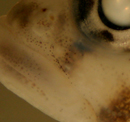 |
discrete oblique line of melanophores from
the orbital rim at 7-8 o'clock to the mid-maxilla
on darker fish, not continuing onto the
lip (premaxilla); just a few deeper melanophores
on the most pallid fish
-develops after transition, about 10 mm
SL
|
vs.
C.
tortugae and C.
bol (variable in C.
dicrus), which have an unmarked area
at 7-8 o'clock on the orbital rim; not a slanted
line on C.
glaucofraenum and C.
venezuelae, on which it is part of
the under-eye stripe
-C.
thrix have the same oblique line,
but it continues onto the lip (premaxilla) |
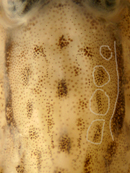 |
lower
eye-stripe (orange or black) not running below
the eye level (can have a white bridle);
mid eye-stripe with no dark dorsal projections,
on pallid individuals only an orange stripe
outlined with tiny melanophores;
upper eye-stripe variable, can become a few
rounded spots;
no chain link loops connecting midline spots
-eye-stripes develop on darker fish after
about 15 mm SL |
vs. most other sand gobies, on which the lower
orange or black eye-stripe runs under the
eye on adults (except
C. thrix and C.
alloides)
vs. C.
bol, C.
tortugae, C.
glaucofraenum and C.
venezuelae, which have triangular
or oblong dark dorsal projections on the mid
eye-stripe
-C.
thrix share the pattern; C.
dicrus have more rounded spots on
the upper head |
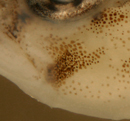 |
stripe
on the lower cheek from the corner of the
jaw usually short and angled sharply-upward
(pointing forward of the dorsal-fin origin)
-angles upward on adults after about 20 mm
SL |
vs.
most the other sand gobies, on which the stripe
points toward the mid or upper pectoral-fin
base, often long, extending across to the
preopercle
-some larger C.
thrix have the same pattern |
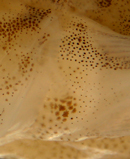 |
variable
spot at the lower pectoral-fin base (none
on pallid fish), often a broad patch or stripe
or oval
-only on darker fish after about 25 mm SL |
vs.
dark C.
tortugae, which have no markings at
the lower pectoral-fin base
-other sand gobies share a variable spot or
markings on darker individuals |
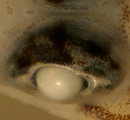 |
a
short extended second-dorsal-fin spine
-develops uncommonly after about 18 mm SL |
vs.
C.
thrix, which often have a much longer
extension (many exceptions that overlap) |
few
large round and comma-shaped black patches
over the dorsal aspect of the eye (4-6)
-from transition |
vs.
C. thrix, which have a speckling of
mixed large and small irregular black spots
(>10) over the dorsal aspect of the eye |
| basicaudal
bar short and simple |
vs.
C.
glaucofraenum and C.
venezuelae, which have two rounded
colon-like spots |
 |
innermost
pelvic-fin rays often shorter than the next
ray
-develops after about 20 mm SL, highly variable |
-C.
dicrus, C.
alloides, many C.
thrix, and occasional individuals
of other sand gobies share the short innermost
rays |
| pelvic
fin fused, frenum well-developed |
vs.
C.
alloides with divided pelvic fins
and C.
dicrus with no frenum |
|
| Coryphopterus
eidolon juvenile, pallid |
| 13.9 mm SL, DNA confirmed
ID |
| head and basicaudal
bar markings only |
| La Parguera, Puerto
Rico, PR784a |
|
 |
| Coryphopterus
eidolon juvenile |
| 14.0 mm SL, DNA confirmed
ID |
| heavily-marked form |
| Colon, Panama, N7530b |
|
 |
| Coryphopterus
eidolon juvenile, pallid |
| 13.9 mm SL, DNA confirmed
ID |
| 8 o'clock bar, no head
stripes |
| La Parguera, Puerto
Rico, PR784a |
|
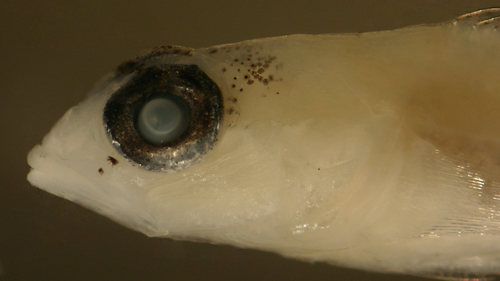 |
| Coryphopterus
eidolon juvenile |
| 14.0 mm SL, DNA confirmed
ID |
| heavily-marked form |
| Colon, Panama, N7530b |
|
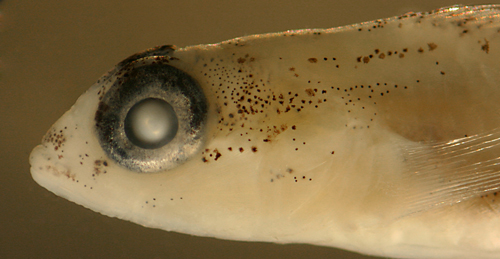 |
| Coryphopterus
eidolon juvenile, pallid |
| 13.9 mm SL, DNA confirmed
ID |
| evenly-sized head melanophores |
| La Parguera, Puerto
Rico, PR784a |
|
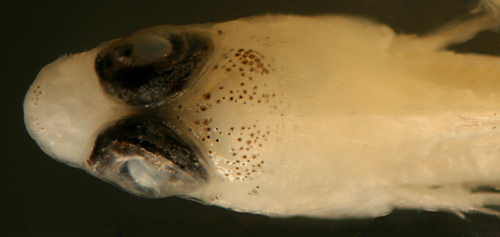 |
| Coryphopterus
eidolon juvenile |
| 14.0 mm SL, DNA confirmed
ID |
| heavily-marked form |
| Colon, Panama, N7530b |
|
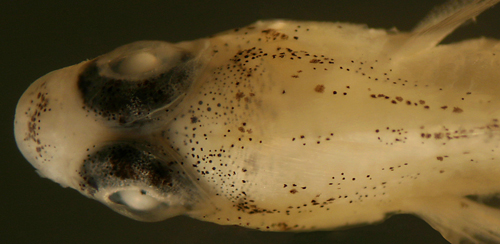 |
| Coryphopterus
eidolon super-pallid |
| 36.5 mm SL, DNA confirmed
ID |
| La Parguera, Puerto
Rico, PR784a |
|
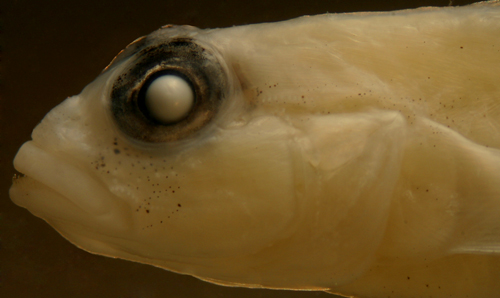 |
 |
|
| Coryphopterus
eidolon pallid |
| 33.3 mm SL, male, DNA
confirmed ID |
| no under-eye stripe,
8 o'clock oblique line |
| mid eye-stripe with
thin outline |
| La Parguera, Puerto
Rico PR784a |
|
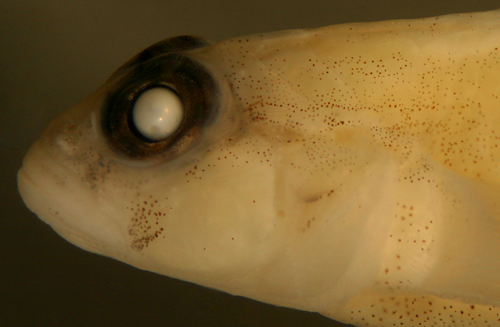 |
|
|
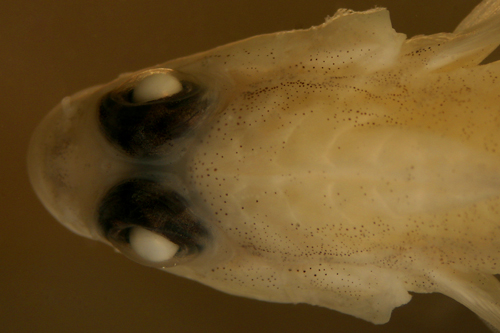 |
 |
|
| Coryphopterus
eidolon dark |
| 30.0 mm SL, male, DNA
confirmed ID |
| no under-eye stripe,
8 o'clock oblique line |
| no dark projection
on mid eye-stripe |
| Colon, Panama N7531a |
|
 |
|
|
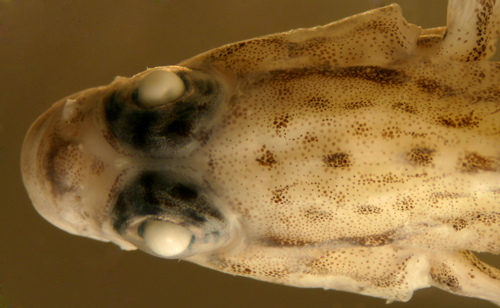 |
|
|
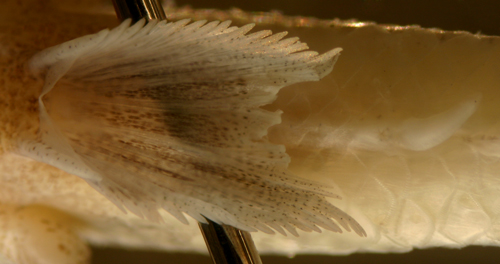 |
| Coryphopterus
eidolon |
| 33.5 mm SL, DNA confirmed
ID |
| no under-eye stripe,
8 o'clock oblique line |
| no dark projection
on mid eye-stripe |
| Colon, Panama N7530b |
|
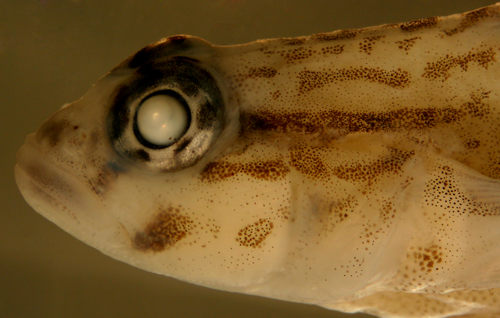 |
|
|
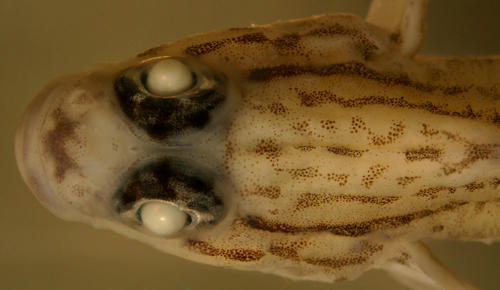 |
|
|
|
|
|
|
|
|
|
Diagnosis: Coryphopterus
thrix, or the inaptly-named bartail goby (most
congeners share the bar on the tail), is one of
several 10/10 sand gobies. A more helpful common
name would be the speckled-eye goby, since this
is often the only distinctive character of these
gobies, especially on live fish. This species
is typically found in offshore sand channels and
around patch reefs near dropoffs in deep clear
water. Most populations are pallid, some with
very few markings (the speckled eye is then the
only character separating them from very pallid
individuals of similar species, especially C.
tortugae, C.
bol, and C.
eidolon). Some C. thrix from continental
coastlines can be heavily-marked.
The suite of characters that distinguish adult
C. thrix comprise (in order of usefulness):
|
|
|
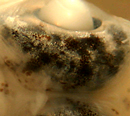 |
speckling
of mixed large and small black spots (>10)
over the dorsal aspect of the eye, irregular,
sometimes reticulated
-develops after about 12 mm SL |
vs.
other sand gobies, which have a few large
round and comma-shaped black patches over
the dorsal aspect of the eye (5-8); very distinct
on fish from deeper waters, obscured by shading
in shallow areas |
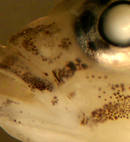 |
discrete oblique line of melanophores from
the orbital rim at 7-8 o'clock to the mid-premaxilla,
i.e. continues onto the lip; on pallid fish
the line is typically present, although
sometimes deep and inconspicuous
-develops after transition, about 10 mm
SL
|
vs.
C.
tortugae and C.
bol (variable in C.
dicrus), which have an unmarked area
at 7-8 o'clock on the orbital rim; line not
discrete on C.
glaucofraenum and C.
venezuelae, on which it is part of
the under-eye stripe
-C.
eidolon
have the same oblique line, but it does not
extend onto the lip (premaxilla) |
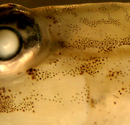 |
lower
eye-stripe (orange or black) not running below
the eye level;
mid eye-stripe with no prominent dark dorsal
projections;
upper eye-stripe variable, can become spots;
no chain link loops connecting midline spots
-eye-stripes develop on darker fish after
about 15 mm SL |
vs. most other sand gobies, on which the lower
eye-stripe runs under the eye on adults (except
C.
eidolon and C.
alloides)
vs. C.
bol, C.
tortugae, C.
glaucofraenum and C.
venezuelae, which have triangular
or oblong dark dorsal projections on the mid
eye-stripe
-C.
dicrus
and sometimes C.
eidolon also have rows of round spots
behind the upper eye |
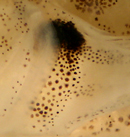 |
prominent
black area uniformly covering upper third
of the pectoral-fin base, sometimes present
on pallid fish (not a stripe or central oval
spot)
-develops after about 18 mm SL, but variably
present |
vs.
most other sand gobies, which have a short
stripe across the upper pectoral-fin base;
C.
dicrus adults, which can have a central
rounded sharply-outlined spot on the upper
pectoral-fin base
-dark C.
eidolon can share a similar black
area to lighter C. thrix |
| |
extended
second-dorsal-fin spine, usually back to the
level of the mid or rear soft dorsal fin
-develops after about 18 mm SL, but variably
present; longest on adult males |
vs.
most other sand gobies, with no extension
-short extension on some C.
eidolon (often to the base of the
fifth soft dorsal ray), can overlap in length
with many C. thrix |
| |
stripe
on the lower cheek from the corner of the
jaw usually short and angled sharply-upward
(pointing forward of the dorsal-fin origin)
-angles upward on adults after about 20 mm
SL |
vs.
most the other sand gobies, on which the stripe
points toward the mid or upper pectoral-fin
base, often long, extending across to the
preopercle
-C.
eidolon and some light C.
tortugae have the same pattern |
| |
basicaudal
bar short and simple |
vs.
C.
glaucofraenum and C.
venezuelae, which have two rounded
colon-like spots |
| |
innermost
pelvic-fin rays often shorter than the next
ray
-develops after about 20 mm SL |
-C.
dicrus , C.
alloides, C.
eidolon, and occasional individuals
of other sand gobies share the short innermost
rays |
| |
pelvic
fin fused, frenum well-developed |
vs.
C.
alloides with divided pelvic fins
and C.
dicrus with no frenum |
|
| Coryphopterus
thrix |
speckled upper eye,
extended second dorsal spine, pectoral-fin
base spot,
8 o'clock bar from eye |
| Florida, photo by pipehorse |
|
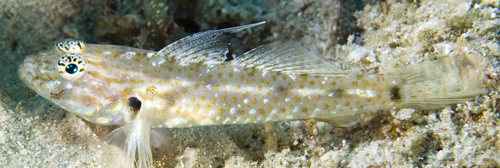 |
|
|
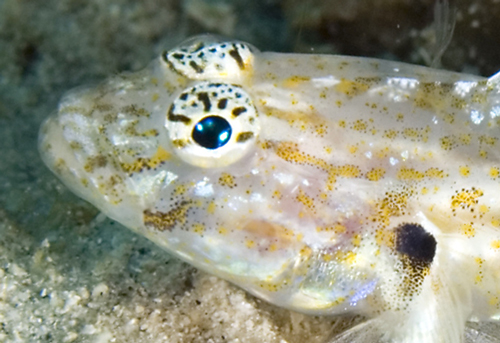 |
| Coryphopterus
thrix |
speckled upper eye,
note isopod parasite on the head |
| photo courtesy Paul
Osmond |
|
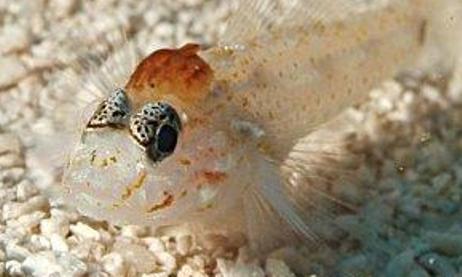 |
| Coryphopterus
thrix juvenile, pallid |
| 14.1 mm SL, DNA confirmed
ID |
| speckled upper eye,
extended second dorsal spine, variably-sized
head spots |
| La Parguera, Puerto
Rico, PR784a |
|
 |
|
|
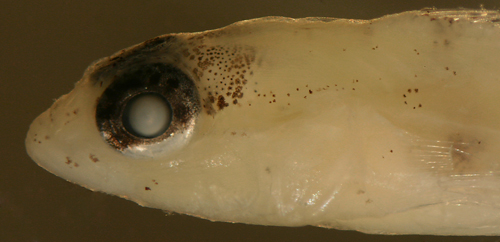 |
|
|
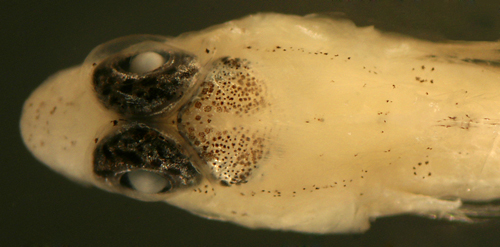 |
 |
|
| Coryphopterus
thrix pallid |
| 22.8 mm SL, DNA confirmed
ID |
| speckled upper eye,
extended second dorsal spine, upper pectoral
base spot |
| La Parguera, Puerto
Rico, PR785a |
|
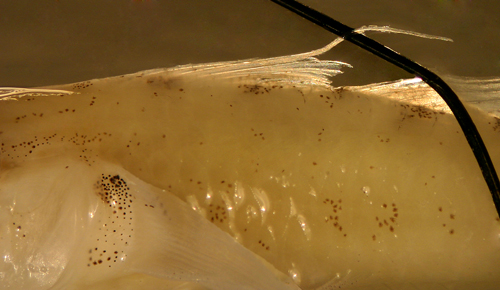 |
| |
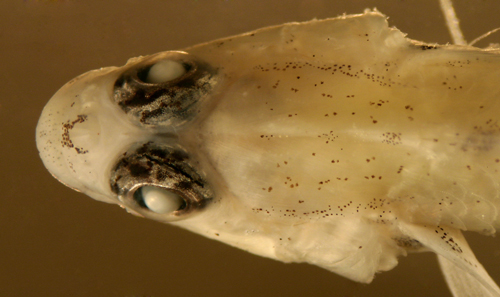 |
| |
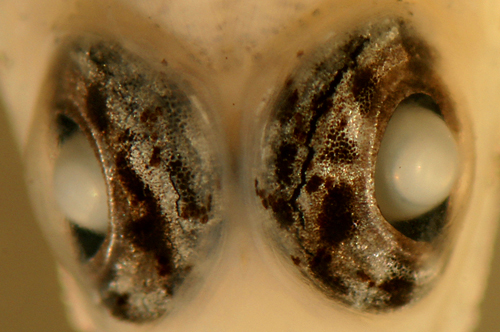 |
| Coryphopterus
thrix, male, dark |
| 27.0 mm SL, DNA confirmed
ID |
| speckled upper eye,
extended second dorsal spine, upper pectoral
base spot |
| Colon, Panama n7531a |
|
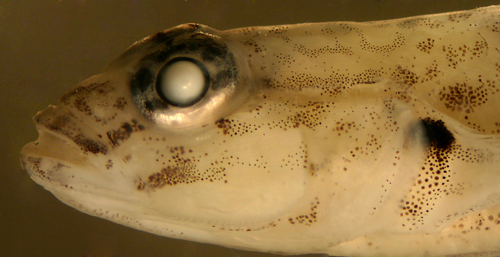 |
| |
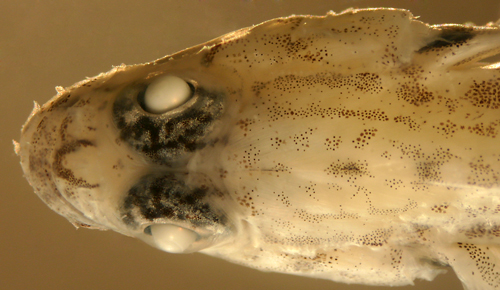 |
| |
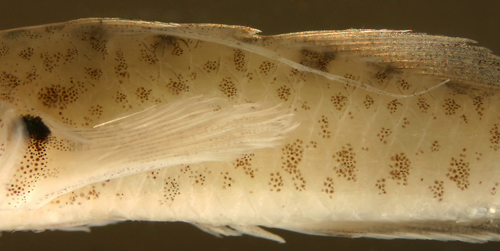 |
| |
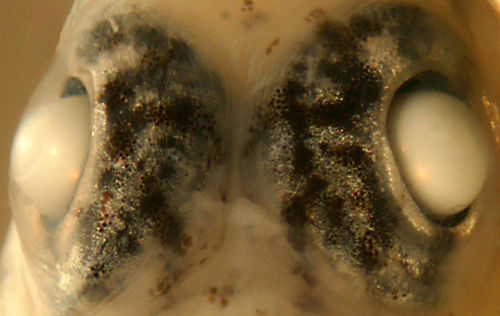 |
| |
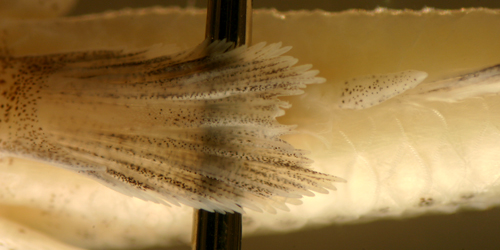 |
| |
|
|
|
|
|
|
| Coryphopterus punctipectophorus |
|
|
|
|
|
|
| |
|
|
Diagnosis:
Coryphopterus punctipectophorus, or
the spotted goby, is distinctive among the sand
gobies for having 11 second-dorsal-fin elements
and 10 anal-fin elements. This temperate species
is found along the cooler northern and central coasts
of Florida and in the Gulf of Mexico, usually in
deeper waters. The suite of characters (in addition
to the unique fin-ray count) that distinguish adult
C. punctipectophorus comprise (in order of
usefulness):
- a sharply-delineated round or oval dark spot
on the lower pectoral-fin base
- no dorsal projection on the mid eye-stripe
- large round colon spots on the base of the
tail, not conspicuous
- a long dark streak along the midline of the
head behind the eyes
- often an 8:30 o'clock dark line from the eye
to the maxilla (under the white)
- mostly complete upper eye-stripe and top of
the head with a chain-link pattern
- fused pelvic fin with a frenum, innermost
rays about equal to next ray
|
|
|
| Coryphopterus
punctipectophorus |
| Destin, Florida (panhandle) |
| |
| photo courtesy James
Garin |
|
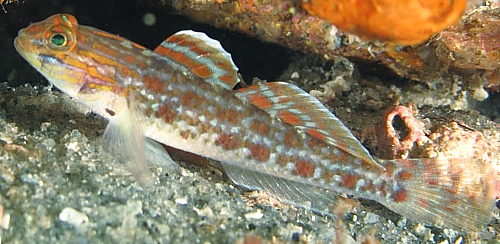 |
| |
|
|
|
|
|
|
|
|
|
|
Diagnosis: Coryphopterus
venezuelae, or the Venezuelan sand goby, is
distinctive among the sand gobies for having 11
second-dorsal-fin and anal-fin elements. Although
there is some variation, over 90% of specimens
I have examined have 11/11, a count that has not
been recorded for either C.
bol (to which it is closely related) or
C.
glaucofraenum (which it closely resembles).
It is found only in the NE part of Venezuela,
around the Gulf of Cariaco and the offshore islands
of Cubagua and Margarita, an area known for unusual
water conditions and a number of endemic species.
In that region, C. venezuelae is found
in a variety of habitats, including shallow inshore
and mangrove habitats, where it replaces the widespread
Caribbean inshore bridled goby C.
glaucofraenum. Around the periphery of
its endemic zone, for example at Mochima, to the
south of Cumana, both C. venezuelae and
C.
glaucofraenum are found in collections
(e.g. GCRL 15947). After separation by dorsal
fin counts, differing marking patterns are quite
evident.
Note: Recruits and juveniles are only
slightly different from C.
glaucofraenum. The earliest difference
is in the length of the melanophore row underlying
the base of the first few anal-fin rays: it extends
over 5 or 6 rays in C. venezuelae and about
3 in C.
glaucofraenum (this difference is visible
on fishes from transition up to about 30 mm SL).
Starting around 12-15 mm SL, C. venezuelae
develop an oval lower pectoral-fin base spot,
becoming a sharply-outlined dark long oval at
larger sizes. On C.
glaucofraenum, there is either no spot,
a group of 3-5 single melanophores, or, at most
a speckling of melanophores in an amorphous cluster,
often extending up to meet the upper pectoral-fin
base markings. Interestingly, the first 3-5 central
melanophores often remain the darkest in the center
of the amorphous cluster. At all sizes, the colon
spots at the caudal-fin base in C.
glaucofraenum are more rounded and more
isolated than in C. venezuelae, although
the differences are not sufficiently reliable
to separate all individuals. In the direct comparison
of fish from the same collection, C.
glaucofraenum have additional rows of
small markings below the lower-body row of X-markings,
while on C. venezuelae that area above
the anal-fin base is mostly unmarked. Given the
variation in the intensity of markings in sand
gobies, it is unlikely that this will prove to
be a consistent character across habitats.
Other than the diagnostic D-VI,11 A-11 and being
present only in NE Venezuela, the suite of characters
that distinguish adult C. venezuelae comprise
(in order of usefulness):
|
|

|
two colon-like
spots at the caudal-fin base, joined by a constricted
bridge, but with distinctly rounded end-spots
-present at all sizes, darker fish can have extensive
bridging |
vs. most other
sand gobies, which have a bar
-except
C. glaucofraenum, which shares the colon-like
spots and some light C.
tortugae and C.
bol, which can have a dumbell bar of two spots
with bridging melanophores |

|
simple triangular
dark dorsal projection (point-up) on the mid eye-stripe
over the mid-opercle (sometimes with a very small anterior
spike); white spot behind the triangle usually not elevated;
if the spot is followed by another dark triangle, anterior
triangle darker and/or larger than posterior
-develops on large juveniles and adults |
vs. C.
glaucofraenum, which develop a wide two-pronged
dorsal projection split around a white spot elevated
above its row (bridging black is raised over stripe
level), anterior prong lower than posterior
-C. tortugae
and C. bol
share the triangles
-other sand gobies have no such dark triangles
|

|
the melanophore
component of the orange lower eye-stripe continues as
a straight dark stripe forward across the suborbital to
the tip of the jaw; even light fish have a dark edge at
the crossing of the suborbital at mid-maxilla- i.e. above
the fleshy lip (premaxilla) and just above the white bridle
and its melanophore stripe
-on juveniles the stripe can be interrupted by the eyeball,
on larger and lighter adults the dark-on-orange stripe
curves down, but still above the white bridle |
vs. C.
tortugae and C.
bol, with no dark stripe on the anterior orange
segment of under-eye stripe: instead the dark stripe merges
down to the white bridle and its melanophore stripe, leaving
the 8 o'clock suborbital region unmarked; no dark edge
at the crossing of the suborbital at mid-maxilla (behind
the lip, at the end of the orange stripe); on light fish
a simple patch or bar of melanophores under the eye at
6-7 o'clock
-C.
glaucofraenum shares the straight-line stripe |
 |
sharply-outlined
black spot at the lower pectoral-fin base, usually a long
upward-facing crescent or oval
-can be absent on new recruits and very pallid individuals |
vs. C.
glaucofraenum, C.
tortugae, and
C. thrix,
which are variously unmarked, have a broad stripe or unshaped
speckling on the lower pectoral-fin base
-C. bol
share the same-shaped spot,
C. dicrus have a round or oval spot, dark C.
eidolon have a variable spot, and C.
alloides have a stripe |
 |
upper eye-stripe
usually complete, not round spots |
vs. C.
dicrus (and sometimes C.
eidolon and C.
thrix), which have rounded spots instead of an
upper eye-stripe |
| dorsal midline
head spots with chain link loops |
vs. C.
tortugae and C.
dicrus, which have no complete loops or rounded
spots (respectively) |
| pelvic fin
fused, frenum well-developed |
vs. C.
dicrus with no frenum and C.
alloides with divided pelvic fins |
| innermost
pelvic-fin rays usually about equal to next (many exceptions) |
vs. C.
eidolon, C.
dicrus, and C.
alloides which have consistently shorter innermost
rays |
|
| Coryphopterus
venezuelae recruit |
| 11.6 mm SL, 11/11 |
| Mochima, Venezuela,
GCRL 15947 |
|
 |
| vs. Coryphopterus
glaucofraenum recruit |
| 11.5 mm SL, 10/10 |
| Mochima, Venezuela,
GCRL 15947 |
|
 |
| Coryphopterus
venezuelae recruit |
| 11.6 mm SL, 11/11 |
| Mochima, Venezuela,
GCRL 15947 |
|
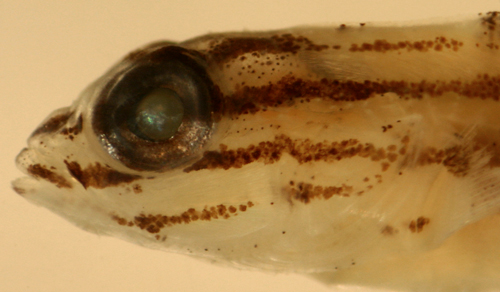 |
| Coryphopterus
glaucofraenum juvenile |
| vs. Coryphopterus
venezuelae juvenile |
| 14.0 mm SL, 10/10,
above |
| 14.9 mm SL, 11/11,
below |
| Mochima, Venezuela,
GCRL 15947 |
|
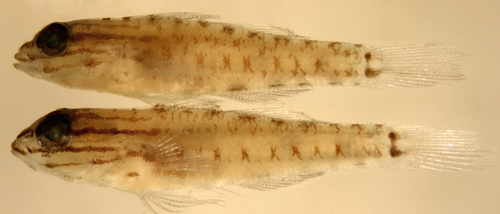 |
|
|
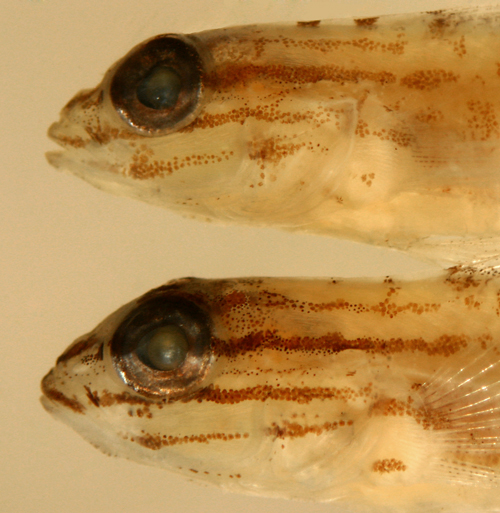 |
| |
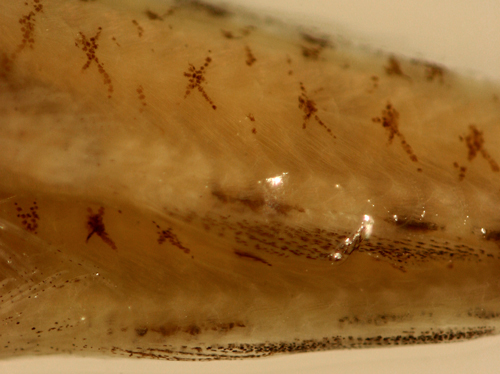 |
| vs. Coryphopterus
bol paratype |
| 24.5 mm SL, DNA confirmed
ID, 10/10 |
| note under-eye stripe
not straight to tip |
| St. Thomas, USVI ST80629 |
|
 |
| Coryphopterus
venezuelae |
| 22.8 mm SL, 11/11 |
| note under-eye stripe
straight to tip |
| lower pectoral spot
oval with sharp edges |
| Mochima, Venezuela,
GCRL 15947 |
|
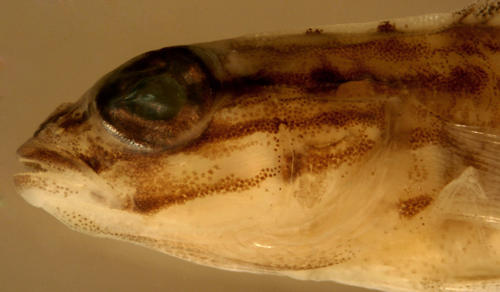 |
| vs. Coryphopterus
glaucofraenum |
| 21.3 mm SL, 10/10 |
| note under-eye stripe
straight to tip |
| lower pectoral spot
without sharp edges |
| Mochima, Venezuela,
GCRL 15947 |
Coryphopterus
venezuelae (above)
Coryphopterus
glaucofraenum (below) |
|
 |
 |
 |
|
|
|
|
|
|
|
|
|
Diagnosis:
Coryphopterus kuna, or the kuna
goby, is distinctive among the sand gobies for
having only 9 second dorsal and anal-fin elements.
This recently-described
species is found widely in the tropical Western
Atlantic: so far sighted in Florida, Yucatan (Xcalak
and Banco Chinchorro), Belize, Honduras (Utila),
Panama, San Andres, Dominica, and Guadeloupe.
It lives on sand and fine-gravel substrates, usually
in deeper water and sandy slopes, and often among
more numerous bridled gobies and Ctenogobius
spp.. Adult C. kuna are tiny, less
than an inch long, and distinguished from other
sand gobies by the absence of head stripes and
the presence of two rows of small but distinct
black spots over the upper aspect of the eyeball,
with 4-6 on the outer row and 2 on the inner.
The spots can be particularly prominent on live
fish. The species is notable for being very short-lived;
in fact, the pelagic larval duration (about 2
months) is typically longer than the post-settlement
life span.
|
|
|
| Coryphopterus kuna
adult female |
| 10.9 mm SL |
| Utila, Honduras |
| |
|
 |
|
 |
| Coryphopterus kuna
adult male |
| 13.3 mm SL |
| Utila, Honduras |
| |
|
 |
|
|
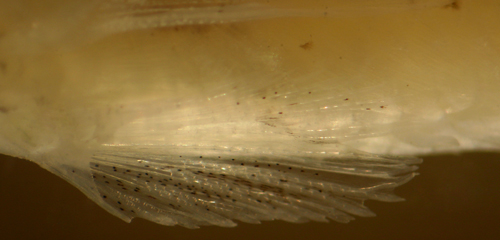 |
|
|
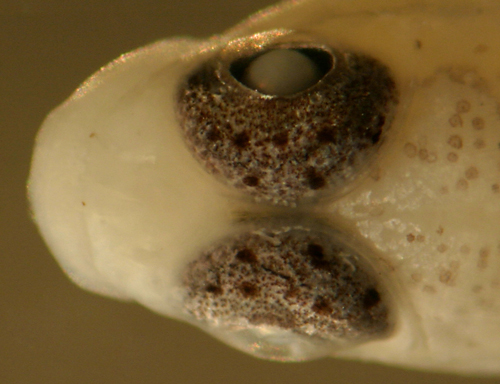 |
| Coryphopterus kuna
adult male |
| 15.2 mm SL |
| Utila, Honduras |
| |
|
 |
|
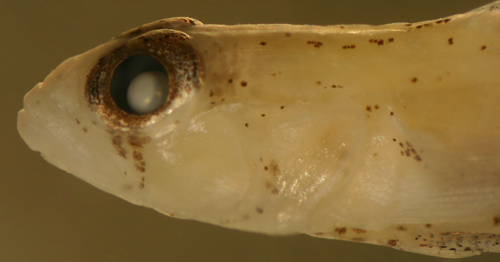 |
|
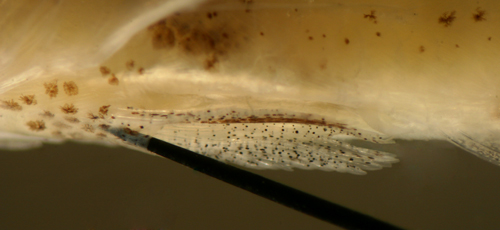 |
|
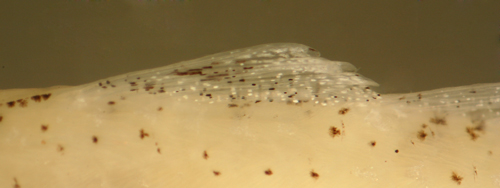 |
| Coryphopterus kuna
adult male, holotype |
| 17.6 mm SL |
| San Blas, Panama, SB82-098 |
| |
|
 |
|
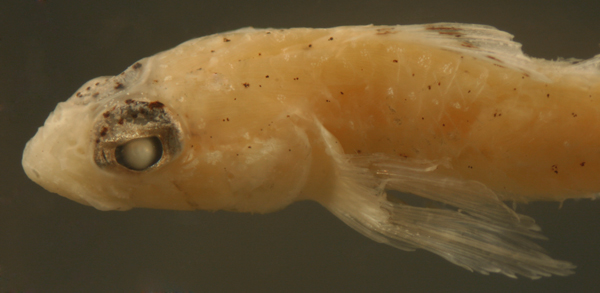 |
| Coryphopterus kuna |
| Palm Beach, Florida |
| courtesy Suzan Meldonian |
| |
|
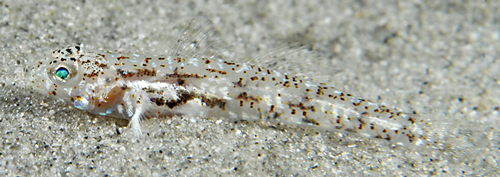 |
|
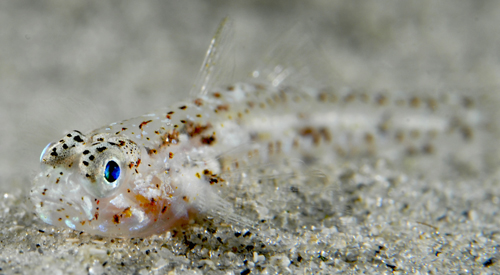 |
|
|
|
|
|
|
|
|
|
Diagnosis: Coryphopterus
alloides, or the barfin goby, is distinctive
among the sand gobies for having mostly divided
pelvic fins, 10 second-dorsal-fin elements and
only 9 anal-fin elements. The barfin appellation
refers to the internal dark bar at midbody, visible
in living fish, that extends to the base of the
spinous dorsal fin. The suite of characters that
distinguish adult C. alloides comprise
(in order of usefulness):
- internal dark bar in live fish
- dark spot at the base of the second dorsal
spine membrane
- mostly-divided pelvic fins
- D-VI,10 A-9
Juveniles develop the internal mid-body bar and
dorsal-fin spot at transition. The divided pelvic
fins do not develop until after about 12 mm SL. |
|
|
|
| Coryphopterus |
| 7.7 mm SL |
| spe |
| San Blas, Panama, SB86-825 |
|
|
|
|
|
|
|
|
|
|
|
Diagnosis: Coryphopterus
lipernes, or the peppermint goby, is a colorful
coral-perching goby found throughout the region.
Adults of the three non-sand Coryphopterus
gobies have divided pelvic fins and a characteristic
black patch at the vent. C. lipernes is
distinguished by iridescent blue and yellow stripes,
most obvious behind the mid eye. In addition,
the scales on the upper body are typically outlined
in a cross-hatch pattern.
Juveniles develop the characteristic light and
dark stripe behind the mid eye (yellow and blue,
respectively, in life) by 10 mm SL, about the
same time that the dark ring around the vent expands
(it is not well-developed on new recruits). The
pelvic fins are fused in small juveniles and divide
only after about 12 mm SL.
|
|
|
|
| Coryphopterus
lipernes juvenile |
| 12.2 mm SL |
| mid eye-stripe |
| St. Thomas, USVI, ST806 |
|
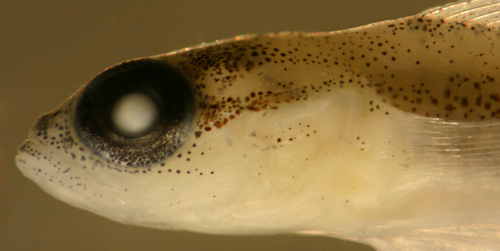 |
| Coryphopterus
lipernes (below) juvenile |
| Coryphopterus
hyalinus (above) juvenile |
| 12.2 mm SL |
| mid eye-stripe |
| St. Thomas, USVI, ST806 |
|
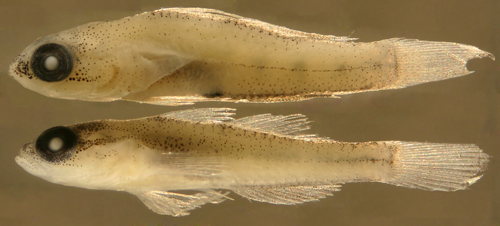 |
|
|
|
|
|
|
|
|
|
Diagnosis: Coryphopterus
personatus, or the masked goby, is a colorful
hovering goby found throughout the region. Adults
of the three non-sand Coryphopterus gobies
have divided pelvic fins and a characteristic
black patch at the vent. C. personatus
is very common in shallow-water where it hovers
over coral heads in large groups, while C.
hyalinus takes its place on coral walls
and in deeper water. The two species can look
quite similar underwater. On close examination,
C. personatus has a single midline anterior
dorsal interorbital pore, while C.
hyalinus has a pair of pores side-by-side.
In addition, C. personatus adults (over
12 mm SL; it is not true for juveniles) can be
distinguished by an unmarked central patch on
top of the head vs. a mostly uniform scattering
of melanophores on adult C.
hyalinus and the obvious stripe behind
the mid eye in adult C.
lipernes.
Juveniles develop the single interorbital pore
by about 10 mm SL. The pelvic fins are fused in
small juveniles and divide only after about 12
mm SL. The location of the vent within the black
spot is an unreliable character on juveniles and
small adults.
|
|
|
|
| Coryphopterus
personatus juvenile |
| 12.4 mm SL |
| San Blas, Panama, SB82-086 |
|
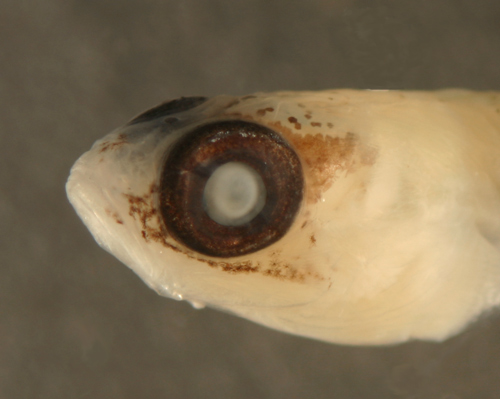 |
| C.
personatus transitional recruit |
| 10.0 mm SL, DNA confirmed
ID |
| single anterior interorbital
pore |
| St. Thomas, USVI, ST-506 |
|
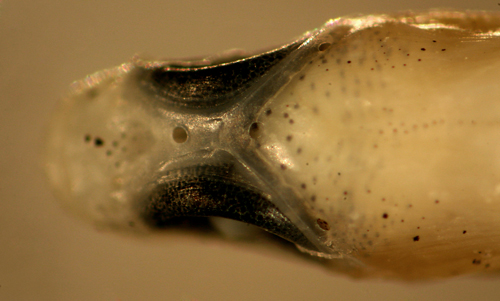 |
|
|
|
|
|
|
|
|
|
Diagnosis: Coryphopterus
hyalinus, or the glass goby, is a colorful
hovering goby found throughout the region. Adults
of the three non-sand Coryphopterus gobies
have divided pelvic fins and a characteristic
black patch at the vent. C. hyalinus is
quite similar to C.
personatus and has the same habits, but
is found on coral-reef walls and in deeper water.
It has a pair of anterior dorsal interorbital
pores side-by-side, while C.
personatus and C.
lipernes have a single midline anterior
pore. In addition, C. hyalinus adults have
a mostly uniform scattering of melanophores on
top of the head and a dark line along the posterior
lateral midline vs. an unmarked central region
on top of the head in C.
personatus and an obvious stripe behind
the eye in C.
lipernes (and no obvious line at the lateral
midline of the body).
Juveniles develop the paired interorbital pores
by about 10 mm SL. The pelvic fins are fused in
small juveniles and divide only after about 12
mm SL. The location of the vent within the black
spot is unreliable on small juveniles.
|
|
|
|
| Coryphopterus
hyalinus juvenile |
| 12.2 mm SL |
| side-by-side interorbital
pores |
| Utila, Honduras, U8703 |
|
 |
| |
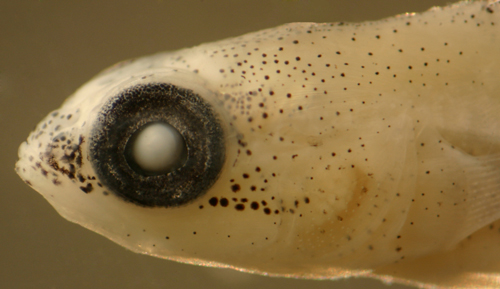 |
| |
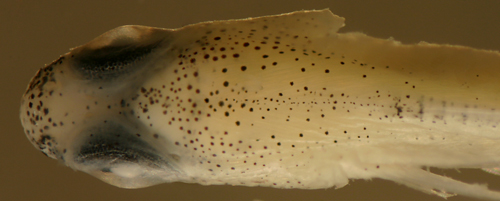 |
| |
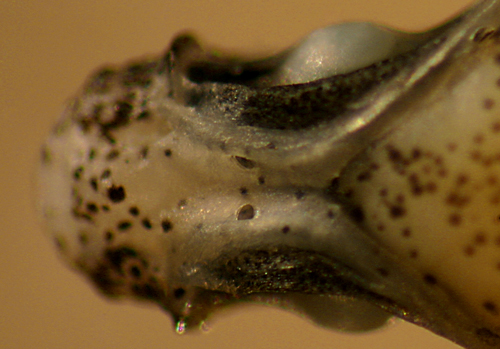 |
|
|
|
|
| |
|
|
|
| |
|
|
|
|
 |
|
All contents © copyright 2006-2014
All rights reserved
www.coralreeffish.com by
Benjamin Victor
|
|
|
|
|
|